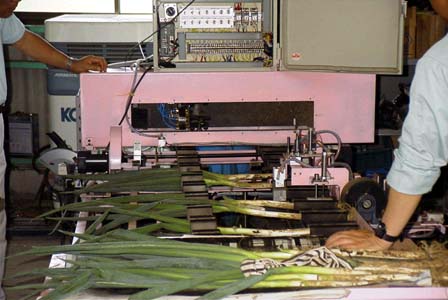トピックス
7
Waves
of
Water
-水の波-非線形相互作用の不思議
Ⅰはじめに
池に小石をなげると、初めは大きな波が小さなさざなみに分解されて消えていきます。これは、波が振動数の異なる波の重ね合わせによりできており、異なる速度で進行するためです。このことを波の分散といいます。1834年8月、イギリスの技師ジョン・スコット・ラッセルは、これとは異なる波を発見しました。それは、分散せずに波の膨らみが形も速さも変えずに何キロも進んでいきます。これは、現在ソリトンと言われています。波の分散性と非線形相互作用がつりあうことによりできます。このソリトンには不思議な特徴があります。
それは、ソリトン同士が衝突すると一度合体しますが、そのあと分離し、衝突前の形で速度も変えずにそのまま進みます。まるで、粒子のように振舞います。このことは、非線形相互作用には記憶効果があると言われています。
注>ソリトンの例: 朝津波、津波、大気の波、木星の赤斑点、金属中の原子の振動、神経細胞の信号伝達、磁場のトンネル(渦ソリトン)、プラズマ加熱の電磁波のソリトン、インスタントン。
注>アマゾン川の朝津波は、高さが7メートルで、800キロメートルも川を遡ります。
注>分散は光にもあります。白色光をプリズムに入射すると、光の波長により異なって屈折します。そのため、プリズムから出た光は分散して虹のような色を見ることができます。
Ⅱ 線形の波
ソリトンは非線形の波ですが、まず線形の波について考えます。線形の波は微小振幅波といわれています。
その波は、以下のようにLaplace方程式に水面と水底の境界条件を指定して速度ポテンシャルΦを求め、ベルヌーイの定理の圧力方程式に代入することにより求まります。
 ・・・(1.1)
・・・(1.1)
水底の境界条件は y=-hで、
 ・・・(1.2)
水面の境界条件は y=0で、
・・・(1.2)
水面の境界条件は y=0で、
 ・・・(1.3)
・・・(1.3)
g:重力加速度
ベルヌーイの圧力方程式から、波の形ηは、
 ・・・(1.4)
・・・(1.4)
波には座標 x および時間 t について cos 関数の形で変化する正弦波を考えます。
 ・・・(1.5)
・・・(1.5)
φ:未知関数、k:波数、ω:角振動数>
(1.5)を(1.1)に代入し、水底での境界条件(1.2)により、
 ・・・(1.6)
・・・(1.6)
従って、波の形 η は (1.4)から以下のようになります。
 ・・・(1.7)
・・・(1.7)
解(1.5)に水面上での境界条件(1.3)をいれると、角振動数 ω、波数 k 、位相速度 c (波 ηの移動速度)、波長λの関係式が得られます。
 ・・・(1.8)
・・・(1.8)
ηが任意波形の場合は、ηは無数の異なった波形の正弦波からなります。各正弦波は境界条件から線形であり、そのため互いに独立で、(1.6)から(1.8)式に従います。
(1.8)式から異なった波長の正弦波は異なった速度で進みますが、このことが波の重ね合わせでできた波の分散が生じる理由です。
注>水面の波の座標系
注>方程式は、速度ポテンシャルΦと非圧縮性流体の連続方程式から求まります。
注>(1.8)式では、波長 λを大きくしていくと、位相速度 c が に近づきます。
に近づきます。
Ⅲ 非線形の波
非線形の波は有限振幅波といいます。有限振幅波では、波を構成する各正弦波が独立ではなく、その間に非線形相互作用が働きます。それが、線形の分散効果とつりあった場合は、波形の変化が止まり、孤立波という定常波ができます。
1895年、ラッセルのソリトン発見から61年後に、KorteWegとde Vriesはラッセルの見たソリトンの非線形方程式を導き出しました(K-dV方程式といいます)。
K-dV方程式は波の高さをu(x,t)とすると、
 ・・・(2.1)
・・・(2.1)
この解には、孤立波の解と周期解のクノイドの解があり、両法とも KorteWeg と de Vries により解決されました。
孤立波の解は、
 ・・・(2.2)
・・・(2.2)
非線形波の孤立波では、速度はλ、波高は 、幅は
、幅は で、各々独立ではありません。
で、各々独立ではありません。
IV. ソリトンの発見
1965年、N.J.Zabusky と M.D.Kruskal は、バネで結ばれた1次元非線形格子のコンピュータ・シュミュレーションによる
Fremi-Pasta-Ulam(FPU)の再起現象に興味を持ちました。彼らは K-dV方程式を数値積分して、再起現象が起きるのを確認しました。初期条件のsin波は、やがて、8個の孤立波に別れて衝突します。衝突の前後で同じ波形であり、独立に運動します。
この孤立波は粒子のように振舞います。そして、やがて、初期条件のsin波に戻ってゆきます。
光子はphotonという、電子はelectronという、音子はphononというにちなんで、ZabuskyとKruskalは孤立波をソリトン(soliton)と命名しました。
ZabuskyとKruskalのコンピュータ・シュミュレーションの結果は、1967年にGardner、Green、Kruskal、Miura
によって逆散乱法という手法により解析的に解を得ることができました。
注>Fremi-Pasta-Ulam(FPU)の再起現象:線形系での基準モード間に、非線形項によるエネルギーやりとりがあると、ある時間がたつと、初期のモードにエネルギーがもどってしまうこと。
注>ソリトン解をもつ方程式をソリトン方程式といいます。K-dV方程式以外に、戸田格子方程式、サインゴールド方程式、非線形シュレディンガー方程式などがあります。
V. ソリトンのアニメーション
ソリトンのシミュレーション(ここをクリックして下さい)。
参考書籍>主に参考にした書籍です。
鏡の伝説(J.ブリッグズ、F.D.ピート)
流体力学(巽 友正)
ソリトンがひらく新しい数学(上野喜三雄)
↑TOP of Page
6
ビープ音とパソコン起動時の障害
Ⅰはじめに
スピーカの付いていないパソコンでも、パソコンを起動するときに“ビー”と音が1回或いは2回鳴ります。これはパソコン内部にある簡易的なスピーカが鳴らしたものです。目的は
BIOSプログラムがハードに異常ないことを知らせるためです。続いて、黒い画面で周辺機器の情報が表示されます。そしてWindowが起動します。ただし、ディスプレイになにも表示されずに継続してビープ音がなることがあります。これは、パソコンのハードウェアの障害です。
注>BIOS(Motherboard
Basic Input/Output System): パソコンのマザーボード(M/B)の制御プログラム。Windowsは各種のマザーボード上で動作しますが、マザーボードのハードの違いをBIOSが吸収しています。
Ⅱ ビープ音の意味
BIOSはパソコンの電源起動時にPOST(power-on self-test)というパソコンハードのセルフチェックを行います。例えば、電源、M/B、CPU、I/Oバスコントローラ、RAM、キーボード、ビデオカードなどです。POST>はディスプレイにエラー内容を表示します。キーボードが接続されていない場合の“Keyboard
error”などはPOSTによるものです。ただし、メインメモリやビデオカードの不良でディスプレイが機能しない場合があります。その場合にエラーを知らせるためにビープ音が使用されます。BIOSにはAMI、Award、Phoenix、Dell、HP、IBM
などがありますが、ビープ音のパターンはメイカーごとに異なり、統一されてはいません(AwardはPhoenix社が扱っています)。
主なビープ音のパターン(ここをクリックして下さい)。
注>POSTのエラーコードを表示するLEDを搭載して、ユーザーにエラーの内容を知らせるM/Bもあります。
注>Windowsが稼働中にビープ音がなるのは、パソコンのCPUの温度以上の場合が多いので、パソコンの電源を切るようにします。
Ⅲ ビープ音がならない場合
パソコンが起動せず、ビープ音もならない場合は、BIOSのパラメータが記憶されているCOMSの不具合が考えられます。その場合、マザーボードについている電池を一度外して、COMSをクリアーします。電池の横にCMOSクリアー用のジャンパーがある時は、ジャンパーを差し替えることによりCMOSをクリアーできます。
Ⅳ 静電気について
静電気とは閉じ込められた電気のことです。絶縁体同士を擦ると静電気が発生しやすいですが、これは電気が漏洩しにくいからです。例えば、ガラスと絹を擦るとガラスはプラスに帯電し、絹はマイナスに帯電します。人間もガラスと同様にプラスに帯電します。帯電したまま、パソコンのM/Bやネットワークカードなどを触れると部品が壊れる原因になります(コンデンサなどの部品に電気が溜まっているだけの場合もあります。その場合、しばらくすると漏洩して回復します)。パソコンの部品に触る場合は、必ず周りの金属に触れて電気を漏洩させます。パソコン自身は内部の部品と絶縁されているので、普通にふれても問題ありません。
注>擦ることによりガラスから絹にマイナスの電気を持っている電子が移動します。プラスの電気を持っている陽子は安定しているため擦っても移動しません。ガラスは電子の個数が少なくたった分、プラスに帯電します。絹はマイナスの電子が増えた分マイナスに帯電します。
Ⅴ BIOSの将来
パソコンに接続する新しいハードウェアを動作させるためには、そのハードウェアのドライバ・プログラムをインストールする必要があります。ただまれに、BIOSプログラムをアップデイトする必要があります。例えば、最新のAGPスロット用のビデオカードなどは、2,3年前のBIOSでは動かないことがあります。
BIOSプログラムのアップデイトですが、BIOSメイカーのホームページからプログラムを無料でダウンロードできます。最近のBIOSアップデイトプログラムはWindows上で動作するので、操作も簡単です(昔はDosでしか動きませんでした)。
現在はBIOSがWindowsのブートストラップローダー(NTLDR)をメモリにロードしてWindowsが起動します。次期のWindowsであるロングホーンではこれが、EFI(Extensifle
Firmware Interface)になります。EFIはインテルが提唱するPlatfrm Inovation Framework for EFIによるものです。80年代のパソコンの登場からからCPUは600倍になり、OSもその構造をかえて進化しています。BIOSだけが進歩から取り残されてきましたが、EFIによりBIOSのプレブート環境も変化しつつあります。
注>NTLDR(NTLoder):boot.iniの読み込み、どのパーティションからシステムを起動するかを決めます。ブート時に必要なサービスを読み込みます。最後にOS>のカーネル(ntosknel.exe)の読み込みを行い、カーネルに制御を渡します。
VI. 参考書籍>お勧めの一冊、パソコンのトラブル対処が詳しいです!
PC自作きょうかしょ―これからはじめる パソコン組み立ての基礎...
人気のある自作教科書です!
挑戦すれば必ずできる...
↑TOP of Page
5
フラクタル音楽
Ⅰはじめに
自然はフラクタル な構造をしています。フラクタルというのは、全体とその全体の一部を拡大 したものが同じ形をしているもののことです。これは自己相似性といい、自然のなかの雪の結晶や樹木、雲、川、地形の起伏、海岸線などにみられます。この自己相似性が時間軸上で現れているものに対しては自己相関があるといいます。これには、株価の変動、地震の変動、交通量、曲の旋律、心拍、脳波などがあります。
Ⅱ 曲の旋律
フラクタル音楽とは自己相関のある曲の旋律のことです。自然の構造を表現するフラクタル図形が美しいように、フラクタル音楽も美しい旋律を表現することを
Richiard F.Voss が発見しました。自己相関の全くない旋律を白色雑音といい、ラジオからときおりでるノイズなどのことです。自己相関の強い旋律を褐色雑音(ブラウン雑音)といい、微粒子のランダムウォークのように予測が難しいにも関わらず現在の位置が過去の位置に依存しているような現象のことです。この中間の雑音のことを1/f雑音といい、この1/fの自己相関が人間にここちよい
旋律を与えてくれることを示しました。
注>fは振動数のことで1/fとはスペクトル理論の用語です。白色雑音は1/f0 、褐色雑音は 1/f2、フラクタル音楽は1/f1のスペクトル密度を持っています。
注>Vossによって示されたのは、自然の変化、人間の経験は1/f雑音の回りに集まっている、そして音楽の楽しみは1/fスペクト ル密度を持つフラクタル音楽に関係している、或いは1/f雑音の模倣かもしれないということです。
Ⅲ フラクタル音楽の作り方
Ⅲ-1白色音楽
白色音楽は、ルーレットを2個用意します。1個はド、レ、ミ、ファ、ソ、ラ、シに分割し、1個は2分音符、4分音符、8分音符に分割します。ルーレットを回すごとにランダムな白色音楽の旋律ができます。
Ⅲ-2褐色音楽
褐色雑音も、ルーレットを2個用意します。一個は白色雑音の場合と同じです。もう一個は、ド、レ、ミではなく、-3、-2、-1,0、+1、+2、+3と音階の差を表すようにします。0の場合を真中の振動数のファとします。-1の時はミです。次に-2がでればドです。この操作を繰り返すと、イチオクターブを超えてしまい、最後にはピアノ鍵盤の外にでていく可能性もあります。そうならないためには、ルーレットを分割する時になるべく-3、-2、+2、+3の分割巾を小さくする必要があります。
Ⅲ-3フラクタル音楽
フラクタル音楽は白色音楽と褐色音楽の真中の比例雑音で表します。それには、3個の赤、緑、青のルーレットを用意し、1、2,3、4,5,6の数字に分割します。3個のルーレットの合計は3から18になるので、それを16の連続する音階に割り当てます。赤を2真数の3ビット目、緑を2ビット目、青を1ビット目とし2進数の(000)2をルーレットの初期状態にします。1回の操作ごとに1ビットを2進数に足し、変化するビットのルーレットだけを次の操作で回すようにします。例えば、1回目のルーレットの値が(1,4,3)で合計が8なので8の音階が求まります。その時、2進数は(001)2に変化するので青のルーレットだけを回し、6が得られたとすると(1,4,6)なので、11の音階が求まります。次に、2進数は(010)2に変化するので緑と青のルーレットを回し、3,3が得られたとすると(1,3,3)なので、7の音階が求まります。次に、2進数は(011)2に変化するので青のルーレットを回し、4が得られたとすると(1,3,4)なので、8の音階が求まります。次に、2進数は(100)2に変化するので赤、緑、青のルーレットを回し、1,2、4が得られたとすると(1,2,4)なので、7の音階が求まります。この方法は、最下の桁がよく変化し、最上位の桁は安定なので合成することにより1/fに近い状況を作り出しています。
注>比例雑音(scaling noise) テープで録音した音のテープ速度を変えても、同じ音色がする音のこと。
Ⅳ. 参考> 白色と褐色の音楽(マーチン・ガードナー 別冊サイエンス)
フラクタル音楽 (マーチン・ガードナー著)
フラクタルイメージ―理論とプログラミング (Michael F.barnsley, Robert L. Devaney, Benoit B. Mandelbrot, Heiz-Otto
Peitgen, Dietmar Saupe, Richard F. Voss)
(Michael F.barnsley, Robert L. Devaney, Benoit B. Mandelbrot, Heiz-Otto
Peitgen, Dietmar Saupe, Richard F. Voss)
↑TOP of Page
4
自動機械
0 はじめに
自動一本ネギ加工機とはネギをコンベヤーにのせると、 根っ子を回転する円形の歯で切断し、ネギの葉っぱと泥皮をエアーでむしりとります。葉っぱはセンサーで検出し、むけるまでエアーの吹きつけをフィードバックさせます。農業試験所と機械屋にたのまれて制御盤とシーケンサーのプログラムを開発しましたが、中国から安いネギが出回ってくるので商品価値はなかったようです。
1 自動1本ネギ加工機
コンピュータ制御による自動ネギの根っ子切断、フィードバック制御による皮むき機械。各種のネギに対応。

↑TOP of Page
3>
起動時のWindowsXPの障害
0 はじめに
新しいプログラムをXPにインストールしたとします。問題なく動作するので安心したとします。次の日にエクスプローラでフォルダにアクセスすると途端にコンピュータがダウンして再起動がかかりました。ログイン後にXPの画壁紙がでてきましたが〔スタート〕メニューとタスクバーが表示されません。ただし、タスクマネジャーは〔Ctrl〕+〔Alt〕+〔Del〕で表示されます。タスクマネジャーから〔新しいタスクを起動する〕でエクスプローラも起動することができました。
突然XPが再起動することは過去にもありましたが、その時に〔スタート〕メニューとタスクバー の表示はありました。 昨日インストールしたプログラムが原因だと仮定します。インストールする前の状態にXPをもどすことができないでしょうか。
1 XPをプログラムをインストール前の状態に戻す
プログラムをアンインストールしても壊れたシステムの部分は壊れたままです。ただしXPにはシステムの復元という機能がありプログラムをインストールする前の状態にもどしてくれます。システムの復元では、重要なシステム
ファイルと一部のプログラム ファイルの "スナップショット" を作成し、この情報を復元ポイントとして保存します。保存した復元ポイントを使うと Windows XP
を以前の状態に戻すことができます。これは、新しいプログラムをインストールするような時に作成されます。昨日で復元を行うと新しいプログラムはインストールされていませんでした。
2 システムの復元の実行
〔スタート〕メニューが表示されていれば、[すべてのプログラム]、[アクセサリ]、[システム ツール] の順にポイントし、[システムの復元]
をクリックすることにより[システムの復元] が起動します。
コマンドプロンプトから[システムの復元]を実行する場合は、コマンド プロンプトで %systemroot%\system32\restore\rstrui.exe
と入力し、Enter キーを押します。通常モードでXPが起動しない場合があります。また、起動時の〔F8〕で〔セーフモード〕のGUIも起動しない場合もあります。[セーフモードとコマンド
プロンプト] オプションでコンピュータを起動し、コマンドプロンプトから[システムの復元]を実行する方法を知っておくことは重要です。
注>管理者または管理者権限があるユーザーとしてログオンする必要があります。
↑TOP of Page
2
MacとWindowsのLAN
0 はじめに
Windowsパソコンを使用している人も、Macとデータ交換をしたいときがあります。開発者の人も最近はマルチプラットフォーム対応が必要ということで、WindowsでもMacでもテストをする必要がでできています。ウインドーズ・フォーマットのフロッピーディスク、MOディスク、CD-ROM、DVDなどを使用すればデータ交換できますが、LANにつながっていれば便利です。WinowsNTサーバーがあれば以下のように簡単に(?)、MacとLANにつないでデータ交換ができます。ただし、10/100BASE-T
EthernetコネクタがWindowsとMacのパソコンに必要です。
1 LANの設定
WindowsNTの設定を最初に行います。
1-1 WindowsNTサーバーの設定
- コントロール・パネルのネットワークを選択します。サービスの追加を選択して、Services for Macintosh をインストールします。この時、NTサーバーのCDが必要です。これで、AppleTalkルーターとして動作できるようになります。
- AppleTalkプロパティの設定では、例えばルーティングのところで次のようにします。ルーティングを行うをチェック、このルータを使ってネットワークをシールドするをチェック、ネットワークの範囲を開始が1、終了も1、ゾーンの追加でゾーン名をZonMacとし、デフォルトのゾーンとします。
- Macがアクセスするドライブだけ、NTFSフォーマットします。コマンド・プロンプトからCONVERTコマンドを実行することにより、FATからNTFSに変換してくれます。
- システムを再起動します。
- 管理ツールのファイル・マネージャを選択します。メニューに MacFileメニューが追加されているので選択します。ボリュームの作成でボリューム名とパスワードを入力します。Macはこのボリューム名に接続する時、このパスワードの入力を求めます。
- MacFileメニューのアクセスは、例えば所有者はAdministrators、プライマリグループはDomainUsersを入力します。
1-2 Macの設定
- Apple Talkを使用に設定します。
- システムフォルダにあるアップルメニューのセレクタを選択します。AppleTalkゾーンにはZonMacが表示されているはずです。AppleShareを選択すると、ファイルサーバーにNTのサーバー名が表示されます。サーバー名を選択してOKし、前記5.のパスワードの入力します。この作業が完了すると、前記5のボリューム名がMacのデスクトップに表示されます。
上記の操作でMacにできたNTの共有ディレクトリは、Mac上からは通常のフォルダと同じ感覚で使用できます。
↑TOP of Page